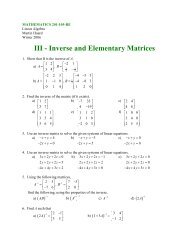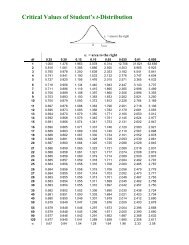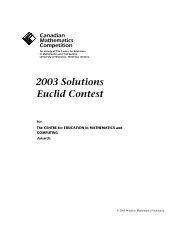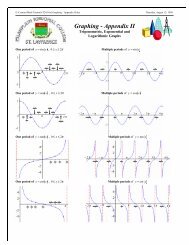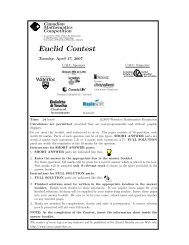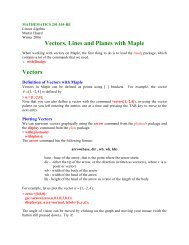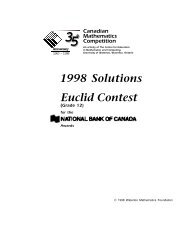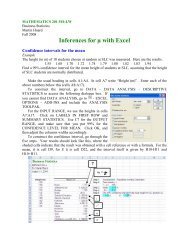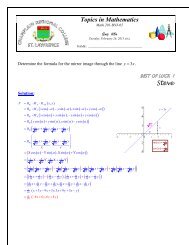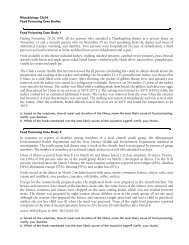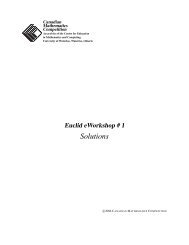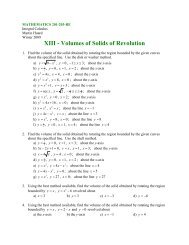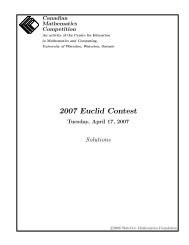Circle Geometry - CEMC - University of Waterloo
Circle Geometry - CEMC - University of Waterloo
Circle Geometry - CEMC - University of Waterloo
You also want an ePaper? Increase the reach of your titles
YUMPU automatically turns print PDFs into web optimized ePapers that Google loves.
Euclid eWorkshop #6<br />
CIRCLE GEOMETRY<br />
CIRCLE GEOMETRY<br />
<strong>Geometry</strong> and more specifically the geometry <strong>of</strong> the circle represents an area <strong>of</strong> mathematics from which relatively<br />
difficult and interesting problems for the Euclid contest are frequently taken. Although this is a very broad content<br />
area, we present only a brief outline <strong>of</strong> some <strong>of</strong> the more elementary results <strong>of</strong> the geometry <strong>of</strong> the circle. We will<br />
assume that the student has some knowledge <strong>of</strong> the elementary properties <strong>of</strong> triangles, including congruence and similarity,<br />
as well as the properties <strong>of</strong> parallelograms, rhombi and trapezoids that follow from these properties <strong>of</strong> triangles.<br />
The ‘Star Trek’ Theorem<br />
The central angle subtended by any arc is twice any <strong>of</strong> the inscribed angles on that arc. In other words, in the<br />
accompanying figure ∠AOB = 2∠ACB.<br />
Demonstration<br />
This theorem is the lynchpin <strong>of</strong> all the results that follow.<br />
It is useful to give a brief demonstration <strong>of</strong> this property to see that if follows directly from the properties <strong>of</strong> isosceles<br />
triangles.<br />
C<br />
O<br />
A<br />
L<br />
B<br />
In the diagram we draw the line connecting C and O and let a point on CO extended be L. Since OA, OB and OC are<br />
radii we have that the triangles OAC and OBC are isosceles. Thus ∠OAC = ∠OCA. Furthermore<br />
∠OAC + ∠OCA = ∠AOL, the exterior angle <strong>of</strong> the triangle. Therefore ∠OCA = 1 (∠AOL). Similarly<br />
2<br />
∠OCB = 1 2 (∠BOL).<br />
Adding these 2 results ∠ACB = ∠ACO + ∠OCB = 1 2 (∠AOL + ∠LOB) = 1 2 ∠AOB.<br />
Extensions<br />
See if you can extend this theorem to obtain each <strong>of</strong> the following:<br />
1. Show that if the chord AB is a diameter then ∠ACB = 90 ◦ . (The angle subtended by a diameter is a right<br />
angle).<br />
2. Show that the result is still true if ∠AOB is greater than 180 ◦ .<br />
3. Show that the result is true in the case where the point C is chosen so that the segments AC and OB intersect,<br />
that is, when C is moved along the circle towards the point B. (This pro<strong>of</strong> will use differences where the earlier<br />
pro<strong>of</strong> uses sums).<br />
4. Show that if C 1 and C 2 are 2 different choices for the position <strong>of</strong> the point C along the arc AB then<br />
∠AC 1 B = ∠AC 2 B. This result is described as ‘angles subtended by the same arc(or chord) are equal’.<br />
(The two points must both lie on the same side <strong>of</strong> the chord).<br />
5. If C 1 and C 2 are two points on the circle, one on the minor arc AB and the other on the major arc AB, prove<br />
that ∠AC 1 B + ∠AC 2 B = 180 ◦ (the opposite angles <strong>of</strong> a cyclic quadrilateral are supplementary).<br />
CANADIAN MATHEMATICS COMPETITION 2



